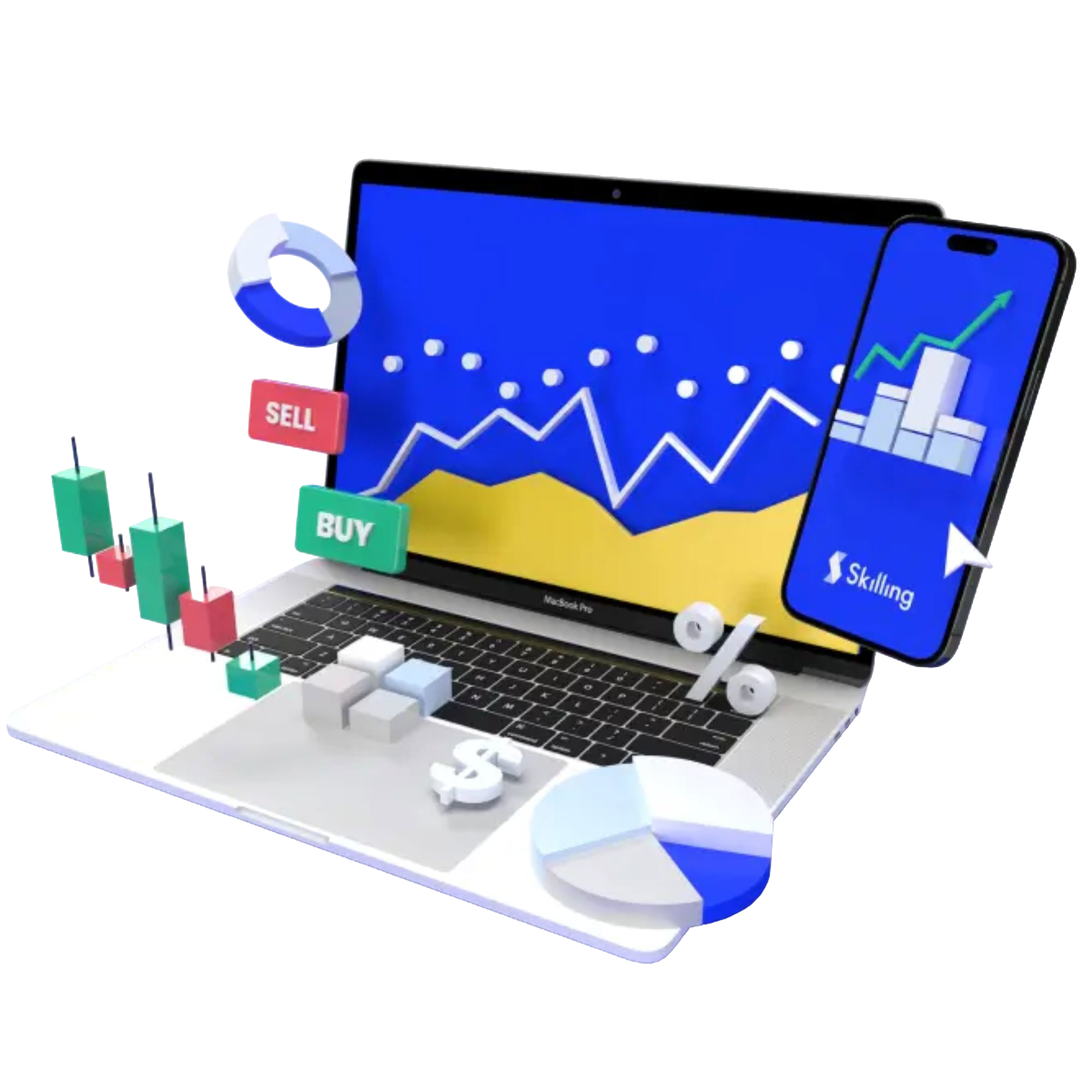ETFs, or Exchange-Traded Funds, are investment vehicles that have gained immense popularity in recent years due to their accessibility and flexibility. In this guide, we will cover everything you need to know about ETFs, including their definition, benefits, types, working mechanisms, and differences with stocks and indices. Additionally, we will provide an overview of the most popular ETFs across regions, including the EU, US, Latam, and Asia, and whether ETFs pay dividends.
Capitalise on volatility in index markets
Take a position on moving index prices. Never miss an opportunity.

What are ETFs?
Exchange-traded funds (ETFs) are a popular investment vehicle that have gained widespread acceptance among both institutional and individual investors in recent years. They have become a powerful tool for investors seeking exposure to a diversified portfolio of assets, with lower transaction costs and greater flexibility than traditional investment vehicles.
The basic concept of ETFs is straightforward. They are funds that are traded on stock exchanges, just like individual stocks. ETFs pool investors' money and invest that money in a varied portfolio of underlying assets, such as stocks, bonds, commodities, or currencies. This allows investors to gain exposure to a range of assets in a single investment, making it a convenient and cost-effective way to diversify their portfolios.
The main benefits of ETFs are:
- Flexibility: Because they are traded on exchanges like stocks, investors can buy and sell shares throughout the trading day, providing greater convenience and flexibility than traditional mutual funds as it allows them to adjust their investment strategies in response to changing market conditions, without having to wait until the end of the trading day to make a transaction.
- Affordability: ETFs typically have lower management fees and expense ratios than traditional mutual funds, making them a more cost-effective investment option.
- Transparency: Unlike traditional mutual funds, most ETFs disclose their holdings daily, allowing investors to see exactly what assets they are investing in.
- Diversification: ETFs offer investors greater diversification. By investing in a broad range of underlying assets, these investments provide traders with exposure to multiple markets and sectors, reducing their exposure to individual stock or bond risk.
With so many benefits, it's no wonder that ETFs have become such a popular investment choice among investors of all levels of experience.
Types of ETFs
ETFs are available in many different forms, each designed to meet specific investment goals.
- One of the most common types of ETFs are equities, which invest in a diversified portfolio of stocks. They are designed to track specific indices or sectors, such as the SPX500 or the technology sector. They offer traders the ability to invest in a broad range of companies with a single investment, providing diversification and potentially reducing risk.
- Another type is fixed income ETFs, which invest in a diversified portfolio of bonds. They provide traders with exposure to the bond market, which can be an attractive investment option for those seeking a stable source of income.
- Commodity ETFs invest instead in physical commodities such as gold or oil, providing investors with exposure to the commodities market. These can be a useful tool for anyone seeking to diversify their portfolio and hedge against inflation.
- Trading exposure to the currency markets is offered by currency ETFs. They can be invested in speculatively or used as a hedge against currency risk.
- Finally, there are alternative ETFs that invest in non-traditional assets such as hedge funds private equity, or real estate. They provide investors with exposure to a diverse range of assets that are not typically available through traditional investment vehicles.
With so many different types available, there is a wide range of options to choose from, allowing investors to tailor their portfolio to their specific goals and risk tolerance.
How ETFs work
ETFs are passive investment vehicles, which means that they are designed to track the performance of an underlying index or asset. They accomplish this by holding a basket of underlying assets that reflect the composition of the index or asset they are tracking, that may include stocks, bonds, commodities, or other financial instruments. The portfolio held by an ETF is typically determined by a rules-based methodology, which is designed to closely track the performance of the underlying index or asset.
For example, let's say an investor wants to invest in the SPX500, a popular index of 500 large-cap US stocks. Instead of buying individual stocks, the investor can buy shares in an SPX500. The ETF will hold a portfolio of stocks that reflects the SPX500's composition, such that the performance of the ETF closely tracks the performance of the SPX500 index. By investing in an ETF, the investor gains exposure to a diversified portfolio of stocks without having to purchase and manage individual stocks themselves.
ETFs vs stocks and indices
ETFs differ from individual stocks and indices in several ways.
While stocks represent ownership in a single company, ETFs hold a basket of underlying assets and are designed to track the performance of a specific portfolio, whereas individual stocks do not necessarily track any specific benchmark. This means that the performance of an ETF is tied to the underlying assets it holds, rather than the performance of a single company.
In terms of liquidity, ETFs are generally more liquid than individual stocks, as they can be traded throughout the day and have a large number of market participants.
Practice with a Demo Account
Try our demo account and experience real market conditions.

Another advantage of ETFs over individual stocks is that they typically have lower fees than actively managed funds. This is because they are designed to track the performance of an underlying benchmark, rather than relying on the expertise of a fund manager to select individual stocks.
Overall, the ETFs are an attractive option for many investors. By offering low fees, diversification, flexibility, and transparency, ETFs can be a valuable addition to any portfolio.
Most popular ETFs
The most popular ETFs in various world regions are:
- In the EU, the most popular ETFs include the iShares Core MSCI World UCITS ETF, which tracks the MSCI World Index, and the Vanguard UK100 All-World UCITS ETF, which tracks the UK100 All-World Index. Another popular ETF is the Xtrackers MSCI World UCITS ETF, which tracks the MSCI World Index and has a focus on sustainability.
- In the US, the SPDR SPX500 ETF is one of the most popular ETFs, tracking the performance of the SPX500 index. The Invesco QQQ Trust is another popular ETF that tracks the performance of the US100 index. The Vanguard Total Stock Market ETF is also a popular choice among investors, tracking the performance of the CRSP US Total Market Index.
- Latin America is also a region where ETFs have gained significant popularity in recent years. The BBVA MSCI Latin America ETF and the iShares MSCI Brazil ETF are some of the most popular ETFs in this region. The BBVA MSCI Latin America ETF offers exposure to a broad range of Latin American equities, while the iShares MSCI Brazil ETF focuses specifically on Brazilian equities.
- ETFs have also gained popularity in Asia. In Japan, the iShares MSCI Japan ETF is one of the most popular ETFs, providing investors with exposure to a broad range of Japanese stocks. Meanwhile, in China, the CSOP China A50 ETF is a popular choice, offering investors exposure to the 50 largest Chinese companies listed on the Shanghai and Shenzhen stock exchanges.
These ETFs provide investors with exposure to a range of assets across different regions, allowing their portfolios to flourish and potentially increase their returns.
It's important to note that the popularity can vary depending on factors such as market conditions, investor sentiment, and regional regulations.
Do ETFs pay dividends?
One question that investors often ask is whether exchange-traded funds (ETFs) pay dividends. The answer to this question is not straightforward, as it depends on the type of ETF and the assets it holds.
ETFs do not generate profits in the same way that individual companies do. Instead, they typically hold a portfolio of assets, such as stocks or bonds, that generate income in the form of interest or dividends.
So, whether an ETF pays dividends depends on the assets it holds.
For example, an ETF that holds stocks that pay dividends will likely distribute those dividends to its shareholders. Similarly, an ETF that holds bonds that pay interest will likely distribute that interest to its shareholders.
It is important to note that not all ETFs pay dividends. Some ETFs, such as those that track commodities or currencies, may not generate income in the same way that stocks or bonds do, and therefore may not pay dividends.
Investors who are interested in receiving dividends from their investments may want to consider investing in ETFs that focus on dividend-paying stocks or bonds. These ETFs may provide a reliable stream of income over time, which can be beneficial for investors seeking income in retirement or for other purposes.
In summary, whether ETFs pay dividends depends on the type of ETF and the assets it holds. While some ETFs may not pay dividends, others may provide a reliable stream of income for investors. Investors should consider their investment goals and risk tolerance when selecting ETFs, including whether or not they pay dividends.











